If you’ve ever been south of the river in London you’ll probably have seen the Faraday Memorial, even if you didn’t realise it. The Memorial is the big steel cube in the middle of what used to be a traffic roundabout at Elephant and Castle. The area around it is now more pedestrian-friendly. It looks like this.
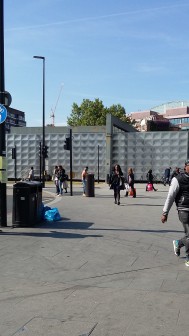
There’s an explanation on a sign beside it. I’ve seen people reading the sign, unlike the days when traffic stopped anyone getting near. Michael Faraday, scientist and inventor, was a local boy. He came from a poor family and didn’t have access to much education, but took it on himself to go to Humphry Davy’s lectures at the Royal Institution. Faraday had been apprenticed to a bookbinder, so he carefully wrote out his notes from the lectures, bound them beautifully and presented them to Davy. That’s how he got his first break. The sign has a very brief summary of Faraday’s life and career, and a little about the memorial and its architect. The memorial is also, appropriately, an electricity substation for the Northern and Bakerloo lines.
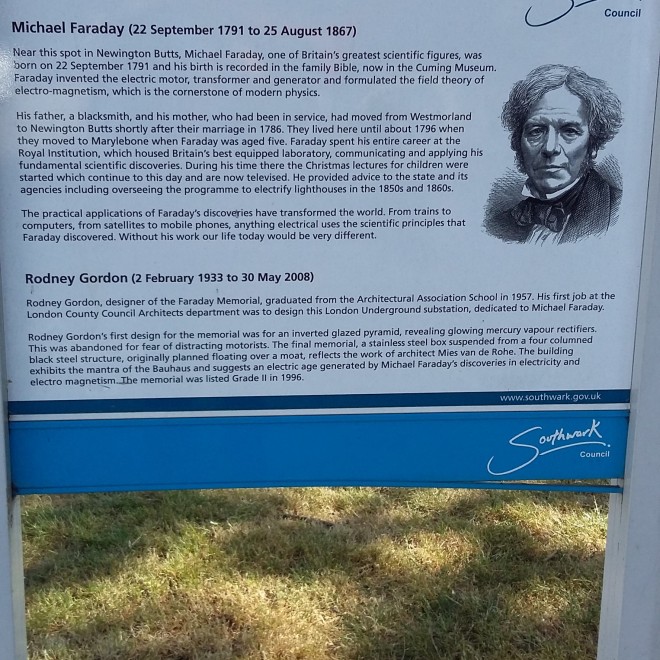
If you want to get much better insight into Faraday’s work, I recommend the Faraday Museum in the basement of the Royal Institution. It is small and a little dingy but Faraday’s laboratory has been preserved and recreated, and there are a lot of extraordinary exhibits. Possibly my favourite ever museum curator’s blurb reads “After discovering electro-magnetic induction, Faraday took a holiday in Hastings.” [Pause badly needed there, if only for comic timing.] It continues: “He then returned to his laboratory and created another world-changing invention: the first electric generator.” It makes me feel I should try a holiday in Hastings this summer.
Here’s a fa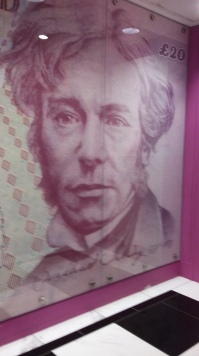 ce you might well recognise, although not at this scale. The museum has a blown-up image of a £20 banknote across an entire wall. The note also featured a drawing of the famous institution lectures.
ce you might well recognise, although not at this scale. The museum has a blown-up image of a £20 banknote across an entire wall. The note also featured a drawing of the famous institution lectures.

You can see one of the earliest ever electric batteries in the museum, given to Faraday by its inventor Alexander Volta in 1814. There is also equipment made by Faraday himself, as he had to make most of his kit from scratch. Insulation didn’t yet exist so in order to make a coil, he and his assistants had to wrap string round wire. It could take a week to make an electric coil like this very early one.
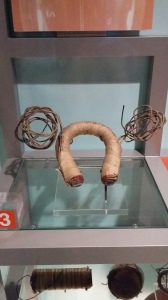
Faraday’s glassmaking experiments, working close-up to the furnace without adequate protection, probably caused some of his health problems. He was trying to make very specialist vessels like the glass ‘egg’ he wanted to use to create vacuums he would then fill with different gases. His experiments in passing an electric current through a variety of gases and metals led to the discovery of spectroscopy, which in turn is the basis of a lot of astrophysics as well as earthly physics. Faraday didn’t only invent electrodes. He also came up with the word. We owe him for some of our language as well as for his discoveries and inventions, and for being a public educator.
There is another, much tinier Faraday museum in London at Trinity Buoy Wharf. I’ll go there one day. In my next post I will also explain what I was really doing at the Royal Institution. Meanwhile, here’s a less interesting but maybe better known public artwork from Elephant and Castle although to be fair, it does feature another London elephant.
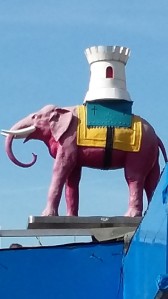

Interesting Dena. The family i work for has commercial properties on Faraday Road in Sydney. Nice to know the origin of the name.
>
LikeLike
[…] Faraday and the Elep… on The London elephants […]
LikeLike
That Hastings bit is hilarious! I have to go here when I come back to London.
LikeLike